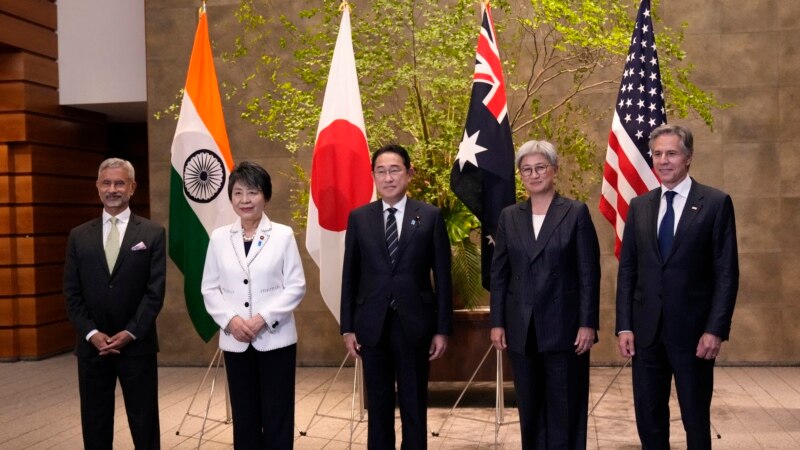Senior diplomats from Japan, the United States, Australia and India meeting in Tokyo on Monday outlined a series of measures to bolster maritime security and cybersecurity and to support other Asia-Pacific countries in enhancing their defenses amid rising tensions in regional seas.
Following their meeting, host country Japanese Foreign Minister Yoko Kamikawa, US Secretary of State Antony Blinken, Australian Foreign Minister Penny Wong and Indian External Affairs Minister Subrahmayam Jaishankar said they were “gravely concerned” by the tensions and expressed “firm opposition” to unilateral changes to the status quo achieved through coercion.
They cited as examples “the militarization of disputed issues and coercive and intimidating maneuvers in the South China Sea,” although they carefully avoided mentioning China in their joint statement.
Several regional governments dispute Beijing’s sweeping territorial claims in the South China Sea, home to crucial trade routes and potential energy reserves. China also claims self-ruled Taiwan as its territory, which it sees as open to forcibly annexing if necessary.
In what are known as Quad meetings, the four ministers agreed on a series of initiatives to counter cyberattacks, ensure maritime security and deal with disinformation. They also announced increased support for other countries, including islands in Southeast Asia and the Pacific, to build capacity in those areas as the Quad seeks to expand its arrangements.
The ministers are expected to launch a maritime legal dialogue focusing on international maritime law. They said they are determined to contribute to maintaining a free and open maritime order in accordance with the United Nations Convention on the Law of the Sea in the Indian and Pacific Oceans and enhance cooperation and coordination in this regard.
Their initiatives included supporting the installation of a secure telecommunications network in Palau and strengthening cybersecurity capacity in the Philippines and India, according to the joint statement. The diplomats reiterated their commitment to improving the region’s connectivity through resilient infrastructure such as submarine cables.
“We are committed to putting our collective resources, our collective strength, to work for the benefit of people across the region that we share,” Blinken said at a news conference after the talks. “We continue to work with partners to ensure that freedom of navigation, overflight, the unimpeded flow of lawful maritime commerce, that these continue. They are critical to the security of the region. They are critical to its continued prosperity.”
Kamikawa said maritime security in the region is increasingly unstable, so more unity and cooperation than ever is needed among the Quad countries to ensure an open, rules-based international order.
Without identifying China, Kamikawa said tensions were escalating in “a certain region” and that cyberattacks from “a certain country” could easily spread to other countries and increase their risks.
“To achieve prosperity in the region, we must ensure the stability of the foundation in the maritime, cyber and space domains,” he said. “The Quad nations aspire to protect the foundations of prosperity in the Indo-Pacific while seeking to achieve an international community of coexistence and co-prosperity.”
Australian Prime Minister Wong said the Quad countries were working towards a region governed by “accepted norms and rules where we can all cooperate, trade and prosper” and where “sovereignty is respected and competition is managed responsibly”.
The talks came after Japan and the United States held a security meeting in which they described China as “the biggest strategic challenge.” They agreed to increase their military cooperation by improving their command structures and bolstering Japanese production and repair of U.S.-licensed weapons.
Connect with the Voice of America! Subscribe to our channels Youtube, WhatsApp and the newsletter. Activate notifications and follow us on Facebook, X and Instagram.



![[Img #74675]](https://thelatestnews.world/wp-content/uploads/2024/12/They-discover-a-new-class-of-X-ray-sources-in-the-150x150.jpg)












Add Comment